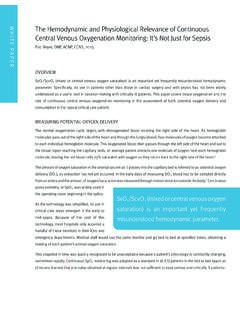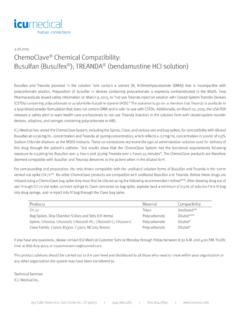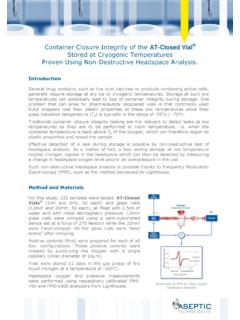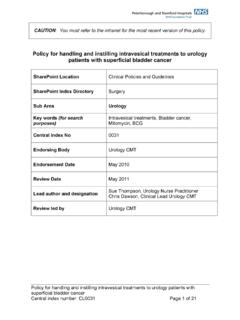Transcription of Evaluation of FDA-Approved ONB Closed-System Transfer ...
1 STUDY SUMMARYE valuation of FDA-Approved ONB Closed-System Transfer devices utilizing cyclophosphamide as a MarkerMichael Koraleski, *, Firouzan Fred Massoomi, *, Matt Zock+ *Nebraska Methodist Hospital, Omaha, Nebraska ; +RJ Lee Group, Inc., Monroeville, PAPURPOSEH ealthcare workers who handle hazardous drugs are at risk of occupational exposure. Closed-System Transfer devices (CSTDs) are specifically designed to minimize this risk. Since their 1999 introduction, it s estimated that less than 45% of facilities use a CSTD. In 2012, the FDA established a new category of CSTDs under a new ONB code that categorizes products to be used for safe handling.
2 Only two CSTDs have received FDA approval for the ONB code: PhaSeal (Becton, Dickinson and Company, Franklin Lakes, NJ) and the newly approved ChemoLock (ICU Medical, Inc, San Clemente, CA). This study examines the containment potential during the drug Transfer process using cyclophosphamide (CP) as a marker for the ONB procedures were used to minimize CP contamination on vials and surfaces prior to the study. Based on published studies, four common surface sampling zones within and around the biological safety cabinet workbench that were suspected to be the most likely contaminated surfaces were selected and demarcated using colored tape.
3 Each CSTD system consists of a vial access device, syringe adaptor, and intravenous bag spike. The systems were used according to the FDA-Approved package insert by a certified pharmacy technician. For the assessment, three trials, which included three individual transfers of 16 mL of drug from each of four vials, followed by disconnecting and reconnecting from vial to IV bag, occurred. A total of 72 individual compounding transfers were completed for the study. Wipe samples were taken by an independent certified industrial hygienist from the four sampling zones and from the compounder s gloves after each trail was complete.
4 Between each device, the sample zones were decontaminated to prevent potential cross-contamination bias between devices . Samples were prepared and analyzed by a credentialed laboratory specializing in chemical analysis using a liquid chromatograph that was equipped with dual mass spectrometers (LC-MSMS) with a lower limit quantitation of nanograms (ng) 1. SUMMARY OF ICU MEDICAL CHEMOLOCK TRIALSS ample IDSurfaceArea, cm2C P, n gCP conc., ng/cm2 Comments5296061 Field blanknandna5296062 Workbench left400nd< < < left400nd< , Trial 15296020 Workbench right400nd< < < left400nd< , Trial 25296041 Workbench right400nd< < < left400nd< , Trial 35296046 Workbench right400nd< < < not applicable nd not detected (< ng/sample)Photo 2.
5 PhaSeal system , vial 1. ICU Medical ChemoLock system , vial Rev. 01 2013 ICU Medical 2. SUMMARY OF PHASEAL TRIALSS ample IDSurfaceArea, cm2C P, n gCP conc., ng/cm2 Comments5296038 Field blanknandna5296039 Workbench left400nd< right400nd< < < left400nd< , Trial 15296005 Workbench right400nd< < < left400nd< , Trial 25296067 Workbench < < left400nd< , Trial 35296082 Workbench < < not applicable nd not detected (< ng/sample)RESULTSWipe samples collected from vials following the initial decontamination procedure and prior to use in the study were free of detectable CP. CP was detected on one surface prior to the ChemoLock trial and no detectable CP was found on surfaces prior to the PhaSeal trial.
6 For the ChemoLock system , no CP was detected on working surfaces or the compounders gloves. For the PhaSeal system , CP was detected on the biological safety workbench following trials 2 and 3 and no CP was detected on the technician s gloves. On one occasion during trial 2 of the PhaSeal system , the internal needle of the product became unintentionally exposed with a fluid droplet observed on the needle results of this study suggest that the ChemoLock system was effective in preventing detectable surface contamination during three separate trials of simulated compounding activities with known amounts of cyclophosphamide .
7 It appeared that the PhaSeal system was effective in preventing detectable contamination when the product functioned as designed. The ONB FDA-Approved devices demonstrate minimization of contamination to the work environment for 4. PhaSeal system , IV bag 6. Wipe sample collected from BSC workbench (left).Photo 3. ICU Medical ChemoLock system , IV bag 5. PhaSeal Protector with unintentionally exposed needle and visible fluid Wipe Study Funded by ICU Medical Inc.















